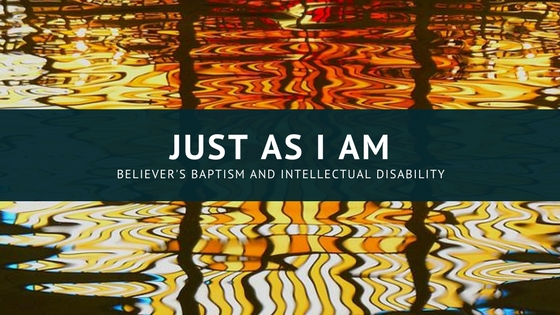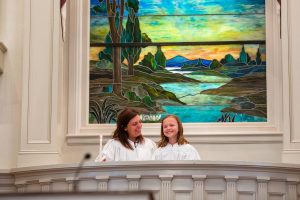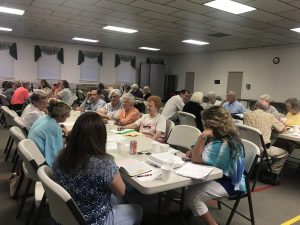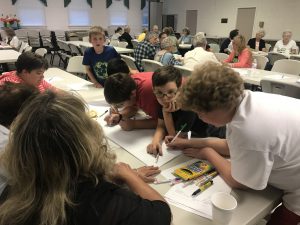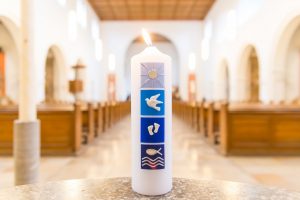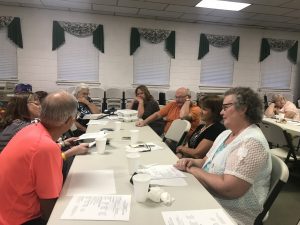Introduction
I have a friend named Billy. Billy has been a part of my worshiping community at First Baptist Church, Winchester, Virginia for about six years. He sits toward the back of the sanctuary with his parents and wears headphones during the service in order to block out the loud noise of the organ. But with or without headphones, Billy is always listening and learning. As an adopted 23 year old with autism and intellectual disabilities, Billy’s life has been marked by very particular and personal struggles. In the midst of those struggles, First Baptist has become another adopted family of sorts, one whose job it is to join his parents in the nurture and affirmation of his faith.
Because of Billy’s presence, I have come to recognize how some of First Baptist’s congregational rituals and practices, while defining and expressing the identity of our church body, also create restrictions to membership and full participation for those who do not communicate or function in what society or what the church might imagine to be typical ways. Of particular concern for this project is the practice of believer’s baptism. In the free church tradition, baptism occurs only when an individual responds to God’s grace by personally claiming and testifying to his or her faith. Questions of readiness, understanding, and belief all play important roles in determining how, when, and who to baptize. Is believer’s baptism an option for those with intellectual disabilities like Billy?
Believer’s Baptism and Baptist Theology
Which Believers?
To answer that question, I first had to learn more about what Baptists mean when they say “believer.” Anthony R. Cross, in his book Baptism and the Baptists: Theology and Practice in Twentieth-Century Britain notes that Baptists have variously understood baptism as the door to the church; a profession of faith; a symbol of death, burial, and resurrection; union with Christ; an act of obedience; and a proclamation of the gospel.[1] The common thread connecting these understandings, however, is the belief that baptism signifies an inward shift or conversion on the part of an individual.[2]
Yet the issue remains: what are the guidelines by which one measures conversion, faith, or belief? As Wayne Stacy notes in A Baptist Theology, the notion that one can fully understand faith is fundamentally flawed. He writes,
“If one has to ‘understand’ before one can appropriately submit to baptism, then would somebody please identify for me that absolute, non-negotiable ‘something’ that must be understood? And even if we could establish such a thing, who among us will decide when it is properly understood?”[3]
This is the crux of the issue as Baptists begin to negotiate how their theology shapes their practice—and vice versa—in light of intellectual disability.
Rethinking Personhood
Baptists are not the only Christians who struggle with these notions of belief and understanding in the journey of faith. In fact, the most prevalent and common understanding of theological anthropology in Western theology locates the imago Dei within a human’s capacity to reason or act. The telos of being human is, in this definition, the refining of and utilization of those capabilities.[4] If this is the case, then those who do not share those capacities of reason or will cannot participate in the full experience or purpose of human life nor can their lives be regarded as inherently good.[5] John Swinton writes, “Behind these types of debates about personhood lurks a particular view of what human beings are and should be and what desirable human living should look like. In other words, they are morally biased and deeply value-laden even if they hide behind the mask of logical rationality.”[6]
Offering an important corrective, disability theologians situate identity within relationships rather than agency or reason. Thomas E. Reynolds argues that “self-definition and social definition are internally related, symbiotic.”[7] Focusing on individual autonomy as the sole basis for human worth is reductive and, ultimately, dangerous. For Reynolds, theologians must reject what he terms the “cult of normalcy”—the notion that there are two categories of humans: normal and abnormal, disabled and non-disabled.[8] He argues, “Disability is not something less than normal, an inferior or broken nature…All people are linked indissolubly, sharing a fundamental condition: vulnerable personhood.”[9] This universal vulnerability and reliance on one another not only constructs a fuller sense of identity but also pushes one to embrace a richer understanding of human solidarity.
As life is recognized as a gift from God, the desire to live autonomous or independent lives is challenged. As Swinton notes, “we need one another to be who we are. Recognition and identity formation are the tasks of the human community.”[10] The work of the church then becomes to embody the same gifts of friendship that each human has received from God. The goal is not simply the inclusion of those who are different or who challenge the common theological anthropology based on reason or agency, but instead a “reshaping of the Christian imagination such that those with disabilities are no longer seen as other.”[11] Within the body of Christ, diversity is celebrated and welcomed. The church becomes the locus of hospitality, a place where individuals come close to one another, learn how to trust one another, and, ultimately, recognize their deep need not only for God but also for each other. Personhood, therefore, is not defined by reason or agency but instead by relationships rooted in mutual vulnerability.
Recovering the Three-Fold Nature of Baptism
This shift in theological anthropology allows Baptists to reclaim a deeper understanding of baptism as well. In this more robust theology of baptism, the response of the individual is important but it is no more important than the work of God or the work of the church. In this way, James McClendon speaks of baptism as a “triply enacted sign, a deed in which God and candidate and (through its designated minister) church all act to effect a turn in one life-story (the candidate’s) on the basis of Jesus’ crucified and risen life. Baptism brings those two lives together in the ongoing ‘life-story’ of the people of God.”[12] Baptism, within this understanding, is part of a larger journey of faith. It marks neither the beginning point nor the end point of an individual’s faith. Instead, it marks a response to God’s preceding work as well as acknowledging the continued work of God in the life of the individual as he or she joins the larger work of the church. The journey of faith for each individual is folded into the common life of the church so that there are both individual and corporate elements.[13] The church, therefore, becomes a witness to the ways that God acts to form and transform the lives of individuals and communities with baptism acting as one marker along the journey of faith. It becomes the job of the practicing community to navigate together what it means to believe, to baptize, and to incorporate each new member into the larger story of God’s work and their shared faith.
The Bible Study
Recognizing this important shift in theological anthropology and the way that it could impact the baptismal imagination of a church, I created an eight-week Bible study for my congregation. The aims of the Bible study were to reclaim a three-fold nature of baptism, both in the practices and in the theology of the congregation. I believed that by decentering the role of the individual, the congregation would be able to reimagine baptismal practices that would create room for those who understood or articulated faith differently.
Pre-Survey
Before beginning the first session of the study, the class was asked to fill out an introductory survey that allowed them to share their understandings of baptism. Each question was open-ended, providing for thoughtful and unique answers from the participants. The survey made clear that the class primarily understood baptism as an individual’s decision to become a Christian. When asked about the appropriate age at which a person should be baptized, 40 percent of the respondents said that a person ought to be “old enough to understand” what baptism signified or meant. When asked what needed to occur prior to baptism, a similar number of respondents named “accepting Jesus” as a requirement. Similarly, most respondents said that “unbelievers” ought not to be baptized, though “unbeliever” was not defined. Though baptism was thought to encompass a large swath of symbolic meanings, most respondents said that it pointed towards faith, an inward change, and new life.
The language used to express the role of the community in baptism was much broader than expected as respondents wrote about the congregation’s role in supporting, welcoming, guiding, and affirming the faith of those seeking baptism. Often, respondents would write more than one sentence to describe the role of the congregation in baptism. However, participants were disturbingly unable to clearly articulate the role of God in baptism with over 35 percent of the respondents noting that they were unsure of God’s role or simply skipping the question altogether. One respondent wrote, “May the force be with us. This is too deep for me.” There was much to be done.
A Church of Water and Fire
Because the class predominately understood baptism through the lens of individual belief, it was necessary to begin the course by first broadening and deepening their theological framework for baptism itself. In order to introduce the rich symbolic world of baptism, the class began by meditating on the role of water in Scripture. Water, it was seen, is employed throughout Scripture as a rich metaphor used to depict danger and deliverance, chaos and creation, boundaries from one way of life or identity to the next, and commissioning into new work. Those themes became our guide for the next few weeks of study. During each session, the class was challenged to see how the symbolic significance of water in Scripture provided a framework for more deeply understanding the symbolic value of baptism as well. Rather than focus only on the mode or subjects of baptism, the class was invited to engage more deeply with the theological framework Scripture provides for the practice.
This interpretive exploration of water in Scripture allowed the class to then move forward to begin exploring how baptism itself was understood and practiced in the early church as well as modern communities of faith today. As noted in the beginning survey, the class struggled to name the ways that God was involved in baptism. This section of the course focused on God’s movement within baptism and within the larger community of faith. Using Robin M. Jensen’s book Baptismal Imagery in Early Christianity: Ritual, Visual, and Theological Dimensions, the class explored the wind, fire, and dove images of the Holy Spirit.[14] Often used to decorate ancient baptismal pools, these images became a gateway by which the class could imagine how the Holy Spirit incorporates an individual into a community. In the depictions of the early church in both Acts and the writings of Paul, baptism becomes the primary identity marker for the new Christian, replacing the other identities of the past.
Triply Enacted Sign
In order to more deeply understand this new identity as part of a community of faith, the class was invited to consider their own particular baptismal practices. The class was challenged to explain why the church uses white baptismal robes, why candidates are given candles, why salt is placed on their lips, why baptismal hymns are sung. Exploring the liturgy and prayers, the language and symbols of our practice, the class was able to begin imagining the connective work of God’s Spirit within the life of a congregation.
The class also viewed various depictions of baptism in television and film as well, noting how each depiction could inform their own conception of baptism. Using scenes from films and television as diverse as Nacho Libre, All in the Family, The Lion King, and O, Brother Where Art Thou?, the class was challenged to think about the role of the individual, God, and the community in each clip.
After a discussion about the selections, the class was asked how our tradition’s focus on an individual and their ability to respond or articulate faith might unintentionally undercut our call to join God in the work of invitation and inclusion, particularly as it relates to those with intellectual disability.
Who’s In and Who’s Out?
One way to reconsider the role of the individual in baptism was to return to Scripture, studying the accounts of baptism in the book of Acts. In each story, the class was challenged to consider how these baptisms not only reshaped an individual but also a believing community. One such story is that of Philip and the Ethiopian eunuch in Acts 8. As Willie J. Jennings notes in his commentary on Acts, this story “highlight[s] a crucial question that the church has struggled to answer: What does it mean to embrace those who are different from us for the sake of the gospel?”[15] For Amos Yong, this story can be read as an analog to disability. Noting that the eunuch could be understood to have disabilities, categorized in the Holiness Code among those with physical defects, Yong writes, “Here the redemption of disability doesn’t necessarily consist in the healing of disabilities but involves the removal of those barriers–social, structural, economic, political, and religious/theological–which hinder those people with temporarily able bodies from welcoming and being hospitable to people with disabilities.”[16]
When studying this text, the class noted the ways that ethnicity, geography, and purity codes all might restrict the eunuch from being incorporated into a believing community. And yet when the eunuch asks: “Look, here is water! What prevents me from being baptized?” (Acts 8:36b) it becomes clear that for Philip, as the representation of the believing community, the answer is that none of the previously conceived restrictions should apply.
This is a hopeful episode in the book of Acts for Baptists who seek to reimagine baptismal practices within the context of intellectual disability. Similarly, in stories such as Peter and Cornelius and Paul and Ananias, baptism becomes a way to affirm belief, experience grace, and build the body of Christ. In each case, those who were typically understood as standing outside the boundaries of God’s grace or God’s people are brought close and invited to join the community of faith.
Inclusion into the community of faith is not separated, however, from the larger work of the church. Philip reads Scripture with the Ethiopian eunuch. Peter and Cornelius are led into deeper understandings of God’s Spirit and the community that Spirit is forming. Ananias helps Paul in his distress, drawing close to him and calling him “brother” despite his history of persecuting Ananias’ people. These acts of discipleship, forgiveness, and community formation are fundamentally important as one comes to understand the proper location of baptism within the larger life and ministry of a congregation.
New Liturgy
At the end of the class, children, youth, and adults worked together to create a new congregational litany in response to baptism. The litany affirmed the newly gained insights into baptism–God’s role, the congregation’s role, as well as the individual’s experience in the waters. It is my hope that this nexus between liturgy and theology will continue to shape the congregation’s understanding and practice of baptism for years to come.
Assessment
Evaluation of Learning Goals
In a follow-up survey given at the end of the class, participants had clearly internalized the broader understanding of baptism as a triply-enacted sign. The language used to describe God’s work in baptism was, for example, much richer and clearer than in the first survey. While before the course 36 percent of respondents had been unable to articulate God’s role in baptism only three percent struggled to answer the question at the end of the class. The answers given in the final survey spoke broadly about the Spirit’s indwelling and inspiration, the salvific work of grace, invitation and acceptance, and guidance and nurture. The community’s work in baptism was also more strongly highlighted. Whereas seven percent of respondents had been unsure how to articulate the community’s role in the first survey, every respondent was able to answer in some way by the end of the course. Answers continued to speak about support, nurture, welcome, and affirmation.
Interestingly, the restrictions on who ought to be baptized were loosened in the final survey as well. The “qualifications” for baptism were not restricted to a certain age or to an ability to express or articulate belief as they were in the first survey. Instead, for most participants, baptism was understood to be withheld only from those who did not wish to be baptized or who did not desire to be in a relationship with God.
Theology and Practice
As we progressed through the study, it was clear that most participants had previously viewed baptism as the result of an individual’s decision to join or become part of a church. Though baptism hinged on a person’s belief, however, the definition of that belief was vague. At first, most discussions about baptism were founded on a particular person’s experience of the practice. It became obvious that for the theological framework around baptism to be strengthened, the practice itself must be more deeply understood. It would not be enough to simply hand the class a new theology of baptism. Instead, the congregational practices of baptism would need to shift and deepen if the theological underpinnings were to change.
Craig Dykstra notes
“After a time, the primary point about the practices [of the church] is no longer that they are something we do. Instead, they become arenas in which something is done to us, in us, and through us that we could not of ourselves do, that is beyond what we do.”[17]
By paying attention to the practice of baptism itself, the congregation was able to make sense of its theological convictions. Dru Johnson notes that often Westerners understand rituals as a way to symbolize belief. Yet rituals are not simply “actions-expressing-thought.”[18] Instead, rituals actually shape knowledge. By studying the baptismal practices of their congregation, the class was able to articulate a stronger and deeper theological understanding of what was occurring in and around baptism. Yet it is my hope that these reshaped practices will, in turn, continue to deepen the congregation’s theological framework for baptism in the days to come.
One of the important insights from this study is that congregations are changed and shaped by those who are incorporated into their membership as each share and offer gifts to one another. At First Baptist Billy not only helped the congregation rethink baptism for him, but for the congregation as a whole.
The things necessary for guiding Billy into faith—nurture, affirmation, and instruction—continue to be the same elements necessary for every person who is baptized in the church.
Though Billy’s impairments are more readily recognized by society, they reflected, for First Baptist, the ways that each of us is impaired in our understandings of the faith God gives us. Over the course of the study Billy shifted from being an exception that the congregation should learn how to accommodate to becoming yet another example and reminder of what it looks like for all Christians to journey authentically into ever-deepening faith.
Conclusion
Of particular interest to me is the way that congregational practices can reflect and, in fact, reform, a congregation’s theology. By moving into deeper understandings of the significance of its practices, a congregation is also able to discern more clearly the theological claims those practices enact. Ultimately, these practices shape a congregation’s faith so that they are able to respond in faithful ways when confronted with challenges to their perceived notions of normalcy.
This has been true in First Baptist’s response to the challenge of intellectual disability.
By shifting away from an emphasis on the individual’s belief to the work and movement of God within the larger practices of the church, the congregation was able to create new spaces for welcome and inclusion for Billy and for anyone else who wished to join their community of faith.
First Baptist has learned that as a congregation invites others to join them in the life of faith, they also commit to supporting and guiding these new members more deeply into faith. At the core of this work is the affirmation that all humans are loved and gifted by God in unique and particular ways. The church, therefore, becomes a place that celebrates that diversity even as it is united by God’s love, mercy, and grace. Baptism becomes another locus of celebration and praise. Rather than acting as a rigid boundary marker, it becomes a site of identity formation, not only for the individual, but also for the congregation as a whole.
[1] Anthony R. Cross, Baptism and the Baptists: Theology and Practice in Twentieth-Century Britain (Eugene, Oregon: Wipf and Stock Publishers, 2000), 29-41.
[2] Ibid., 31.
[3] R. Wayne Stacy, “Baptism,” in A Baptist’s Theology (Macon, GA: Smyth & Helwys, 1999), 153–74, 167.
[4] Hans S. Reinders, Receiving the Gift of Friendship: Profound Disability, Theological Anthropology, and Ethics (Grand Rapids, MI: Wm. B. Eerdmans Publishing Company, 2008), 279.
[5] Ibid., 280.
[6] John Swinton, Dementia: Living in the Memories of God (Grand Rapids, MI: Wm. B. Eerdmans Publishing Company, 2012), 130.
[7] Thomas Reynolds, Vulnerable Communion: A Theology of Disability and Hospitality (Ada, MI: Brazos Press, 2008), 105.
[8] Ibid., 20.
[9] Ibid., 105.
[10] Swinton, Dementia: Living in the Memories of God, 159.
[11] Jason D. Whitt, “In the Image of God: Receiving Children with Special Needs,” Review & Expositor 113, no. 2 (May 2016): 205–16, 213.
[12] James Wm. McClendon, Jr., Doctrine, vol. 2, Systematic Theology (Nashville, TN: Abingdon Press, 1994), 390.
[13] James Wm. McClendon Jr., “Toward a Conversionist Spirituality,” in Ties That Bind: Life Together in the Baptist Vision (Macon, GA: Smyth & Helwys, 1994), 23–32, 26.
[14] Robin M. Jensen, Baptismal Imagery in Early Christianity: Ritual, Visual, and Theological Dimensions (Grand Rapids, MI: Baker Academic, 2012).
[15] Willie James Jennings, Acts, Belief: A Theological Commentary on the Bible (Louisville, KY: Westminster John Knox Press, 2017), 87.
[16] Ibid., 69.
[17] Craig Dykstra, Growing in the Life of Faith: Education and Christian Practices, Second Edition (Louisville, KY: Westminster John Knox Press, 2005), 56.
[18] Dru Johnson, Scripture’s Knowing: A Companion to Biblical Epistemology (Eugene, Oregon: Cascade Books, 2015), 70.
